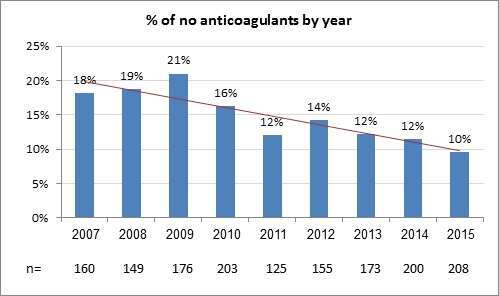
Trends in the Use of Anticoagulation as the Results of the Introduction of the Novel Anticoagulants
Background: Novel anticoagulants (NOACS) were introduced in 2011 for the prevention of stroke in patients in atrial fibrillation (A.F.). We studied the effect of their availability on the use and type of anticoagulation prescribed after cardioversion.
Methods: We retrospectively analyzed all patients with A.F. undergoing cardioversion in a single center and compared the pre- NOAC period (2007-10) with NOAC-available period (2011-5).
Results: Total of 1549 patients had a first cardioversion, 688 during the pre-NOAC and 861 during the NOAC period. Mean age of the patients was 72±12 y., 48% were women. Comparing the pre-NOAC to the NOAC period, the discharge prescription of vitamin K antagonists (VKA) decreased (81.9% to 33.7 %), NOACs increased (0% to 56.7%), and no anticoagulation decreased (18.1% to 9.6 %), pFigure 1 shows the proportions of each anticoagulation strategy per chads2 score in the NOAC period.
Figure 2 shows the percent of patients discharged with no anticoagulation during the all period.
Univariate analysis did not demonstrate significant difference in length of hospital stay between treatment groups. However, adjustment for age, sex and chads2 score revealed that patients on NOACS had a shorter hospital stay than VKA by 0.65 days, (p=0.022)
Conclusions: Since the introduction of NOACs, there is a marked increase in prescribing anticoagulation to patients with A.F. , particularly with NOACs. Their use was associated with shorter hospital stay and reduction in the number of patients discharged without anticoagulation.


Powered by Eventact EMS